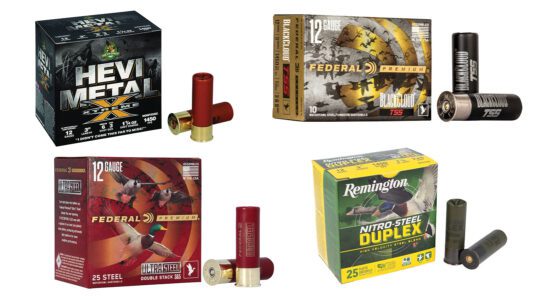
Modern Alchemy - Waterfowlers Benefit From an Industry Trend of Building “Stacked” Shotgun Loads
News Briefs - July/August 2025
Waterfowl hunters these days benefit from a host of innovative loads. That is a welcome development, but the variety of choices can make heads spin—for hunters and retailers alike. A hunter’s ammo menu includes steel, bismuth, tungsten, and TSS (tungsten super shot), each of which offers specific performance benefits. But these non-toxic loads come with sticker shock, because dense non-toxic metals, such as bismuth and tungsten, have higher commodity prices, which do make for a more expensive product. Turkey hunters, who on a good day will take one shot only, can justify the cost of a TSS turkey load, which could be as high as $10 per shell. Waterfowlers, however, expect to shoot a lot more, and at $10 per shell, a day in the blind can become prohibitively expensive.
That’s where a product called “stacked loads” comes into play. Basically, it’s a form of modern alchemy where ammo manufacturers mix pellet sizes and materials to create high-performing shotgun loads for waterfowlers. But just what are these loads?
“A stacked (duplex) load is when you have two different shot sizes in the same shotshell,” says Ronald Evans, Remington shotshell product line manager. “The smaller pellet size, such as No. 4, is most of the time nearest the powder or the bottom of the load; the larger pellets, such as size BB, sit at the top. In most cases, we see improved performance in patterns and effective ranges. Smaller shot delivers denser patterns at close range while the larger shot is effective at longer ranges. This type of load also works well when more than one species of waterfowl is being hunted. If a hunter is chasing ducks, but geese are in the area, he could use a BB and No. 4 load for both birds.”
Mixed Metals
Stacked loads can also comprise different metals. “We will use stacked loads to maximize pattern density and/or increase down-range energy,” says Scott Turner, HEVI-Shot shotshell product line manager. “When dealing with non-toxic materials, we are limited to TSS (18 grams per cubic centimeter), HEVI-Shot tungsten (12.0g/cc), bismuth (9.6g/cc), and steel (7.8g/cc). The higher the density, the higher the material cost. By stacking different materials, we are able to tailor a good balance of cost and performance for the consumer.”
Turner also points out a feature of HEVI-Shot that retailers should bear in mind. “HEVI-Shot is known for its density,” he says. “By using denser products, we are able to reduce the size of the pellets for the same down-range energy. For example, if you shoot a size 3 steel pellet, you can shoot a size 6 HEVI-Shot tungsten pellet or a size 4 bismuth. That way, a hunter can put more lethal pellets on target. That’s why our HEVI-Shot X-treme comes in size No. 1 (steel) and size No. 4 (tungsten). There are two other combinations as well.”
And though stacked steel loads are generally less expensive, retailers should note manufacturers consider them to be premium products. “Non-toxic stacked loads that use steel and either bismuth or a tungsten metal are referred to as a premium or high-performing product and offer performance advantages, such as improved wad systems, over traditional steel loads,” says Joshua Vickers, Federal shotshell product line manager. “In the case of Federal’s new Ultra Steel, which offers steel stacked loads (BB and 2, 2 and 4, and 3 and 5), we have found that by stacking two different steel shot sizes coupled with our FLITECONTROL Flex wad, we were able to notably increase pattern densities in a 15-inch circle at 40 yards, making for a more lethal load.”
Here is a selection of stacked loads that retailers should consider stocking.
Federal
Federal Premium's Black Cloud TSS (12- and 20-gauge): 60 percent HEAVYWEIGHT TSS and 40 percent steel FLITESTOPPER pellets in No. 3 (steel) and No. 9 (TSS) or BB; Ultra Steel: a fifty-fifty mix of all-steel payloads in either 3 and 5, 2 and 4, and 2 and BB in 3-inch 12-gauge. New in 2025 will be 3.5-inch 12-gauge loads in 2 and 4 or 2 and BB. In addition, there will also be a 3.5-inch 10-gauge load in 2 and BB or 1 and BBB.
HEVI-Shot
HEVI-Metal Xtreme: 30 percent tungsten and 70 percent steel in mixed sizes 3 (steel) and 6 (tungsten), 1 and 4, or 2 and BB. New for 2025, HEVI-Steel Layered (12- and 20-gauge) consists of payloads of 100-percent steel in different sizes, such as 3 and 5, 2 and 4, or 2 and BB. hevishot.com
Remington
Nitro Steel Duplex currently comes in four 12-gauge configurations: 2 and 4, 6 and 2, 4 and BB, and 2 and BB. In 2025, Nitro Steel Duplex will introduce three new 20-gauge SKUs in 4 and 6, 2 and 6, or 2 and 4. remington.com
